
The Servite Order, officially known as the Order of Servants of Mary, is one of the five original Catholic mendicant orders. It includes several branches of friars, contemplative nuns, a congregation of active religious sisters, and lay groups. The Order's objectives are the sanctification of its members, the preaching of the Gospel, and the propagation of devotion to the Mother of God, with special reference to her sorrows. The Servites friars lead a community life in the tradition of the mendicant orders.
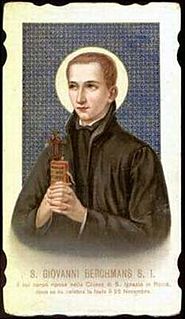
John Berchmans was a Jesuit scholastic and is a saint in the Catholic Church. In 1615, the Jesuits opened a college at Mechelen and Berchmans was one of the first to enroll. His spiritual model was his fellow Jesuit Aloysius Gonzaga, and he was influenced by the example of the English Jesuit martyrs. Berchmans is the patron saint of altar servers, Jesuit scholastics, and students.

Peter Canisius was a renowned Dutch Jesuit Catholic priest. He became known for his strong support for the Catholic faith during the Protestant Reformation in Germany, Austria, Bohemia, Moravia, Switzerland and the British Isles. The restoration of the Catholic Church in Germany after the Protestant Reformation is largely attributed to the work there of the Society of Jesus, which he led. He is venerated in the Catholic Church as a saint and as a Doctor of the Church.

Catholic Mariology is Mariology in Catholic theology. According to the Immaculate Conception taught by the Catholic Church, she was conceived and born without sin, hence Mary is seen as having a singular dignity above the saints, receiving a higher level of veneration than all angelic spirits and blessed souls in heaven. Catholic Mariology thus studies not only her life but also the veneration of her in daily life, prayer, hymns, art, music, and architecture in modern and ancient Christianity throughout the ages.

Salus Populi Romani is a Roman Catholic title associated with the venerated image of the Blessed Virgin Mary in Rome. This Byzantine icon of the Madonna and Christ Child holding a Gospel book on a gold ground, now heavily overpainted, is kept in the Borghese (Pauline) Chapel of the Basilica of Saint Mary Major.
The Sodality of Our Lady (also known as the Sodality of the Blessed Virgin Mary is a Roman Catholic Marian Society founded in 1563 by young Belgian Jesuit, Jean Leunis, at the Roman College of the Society of Jesus. The modern Ignatian lay group, Christian Life Community, traces its origins to the first Sodality.

The Congregation of Marian Fathers of the Immaculate Conception of the Most Blessed Virgin Mary is a Catholic male clerical religious congregation founded, 1670, in Poland. It is also known as Marians of the Immaculate Conception. Its members add the nominal letters M.I.C. after their names to indicate membership in the Congregation.

Mary, Untier of Knots or Mary, Undoer of Knots is the name of both a Marian devotion and a Baroque painting which represents that devotion. The painting by Johann Georg Melchior Schmidtner, of around 1700, is in the Catholic pilgrimage church of St. Peter am Perlach, otherwise known as the Perlach church, in Augsburg, Bavaria, Germany. Pope Francis saw the image while in Germany as a student and promoted her veneration in Latin America.
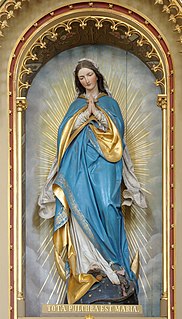
Bis saeculari, is an apostolic constitution, of Pope Pius XII on the Sodality of Our Lady issued to mark the two hundredth anniversary of the Papal bull Gloriosae Dominae of Pope Benedict XIV in 1748.
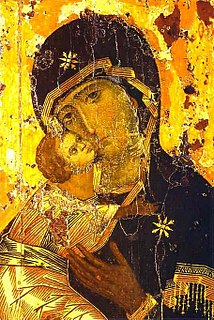
Mariology is the theological study of Mary, the mother of Jesus. Mariology seeks to relate doctrine or dogma about Mary to other doctrines of the faith, such as those concerning Jesus and notions about redemption, intercession and grace. Christian Mariology aims to place the role of the historic Mary in the context of scripture, tradition and the teachings of the Church on Mary. In terms of social history, Mariology may be broadly defined as the study of devotion to and thinking about Mary throughout the history of Christianity.
Mater ter admirabilis, literally "Mother thrice admirable", is a Latin invocation from the Litany of the Blessed Virgin Mary.

The history of Catholic Mariology traces theological developments and views regarding Mary from the early Church to the 21st century. Mariology is a mainly Catholic ecclesiological study within theology, which centers on the relation of Mary, the Mother of God, and the Church. Theologically, it not only deals with her life but with her veneration in life and prayer, in art, music, and architecture, from ancient Christianity to modern times.

Throughout history, Catholic Mariology has been influenced by a number of saints who have attested to the central role of Mary in God's plan of salvation. The analysis of Early Church Fathers continues to be reflected in modern encyclicals. Irenaeus vigorously defended the title of "Theotokos" or Mother of God. The views of Anthony of Padua, Robert Bellarmine and others supported the doctrine of the Immaculate Conception of the Virgin Mary, which was declared a dogma in 1850.

The Mariology of the popes is the theological study of the influence that the popes have had on the development, formulation and transformation of the Roman Catholic Church's doctrines and devotions relating to the Blessed Virgin Mary.
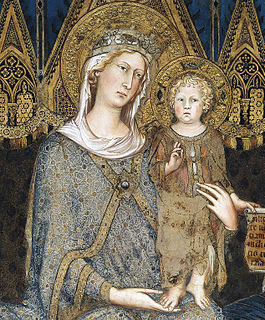
The veneration of Mary, mother of Jesus, encompasses various Marian devotions which include prayer, pious acts, visual arts, poetry, and music devoted to the Blessed Virgin Mary. Popes have encouraged it, while also taking steps to reform some manifestations of it. The Holy See has insisted on the importance of distinguishing "true from false devotion, and authentic doctrine from its deformations by excess or defect". There are significantly more titles, feasts, and venerative Marian practices among Roman Catholics than in other Western Christian traditions. The term hyperdulia indicates the special veneration due to Mary, greater than the ordinary dulia for other saints, but utterly unlike the latria due only to God.

Catholic Marian movements and societies have developed from the veneration of the Blessed Virgin Mary by members of the Catholic Church. These societies form part of the fabric of Mariology in the Catholic Church. Popular membership in Marian organizations grew significantly in the 20th century, as apparitions such as Our Lady of Fátima gave rise to societies with millions of members, and today many Marian societies exist around the world. This article reviews the major Marian movements and organizations.
Romanum may refer to :

Louis-Marie Grignion de Montfort was a French Roman Catholic priest and confessor. He was known in his time as a preacher and was made a missionary apostolic by Pope Clement XI.
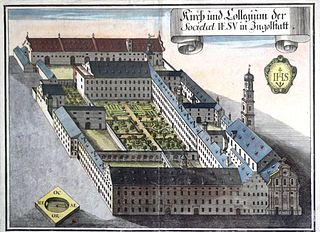
The Jesuit College of Ingolstadt was a Jesuit school in Ingolstadt, in the Duchy and Electorate of Bavaria, founded in 1556, that operated until the suppression of the Jesuit Order in 1773. The college was the headquarters of the Jesuits in Germany, and became a center of the Counter-Reformation. Many of its members taught at the University of Ingolstadt.

Jakob Rem was an Austrian member of the Society of Jesus, a Catholic evangelical organization, and an early member of the Congregation of Marian Fathers. He introduced the phrase Mater admirablis into the litany.